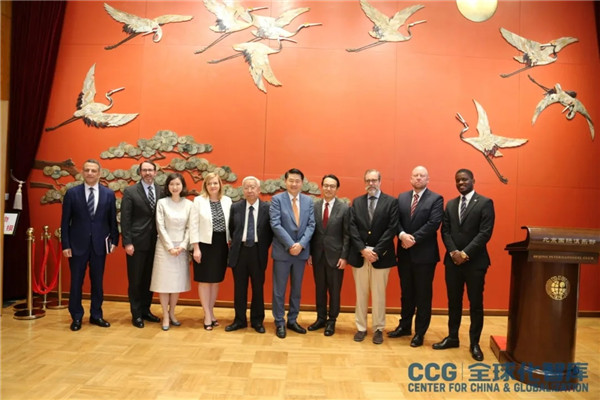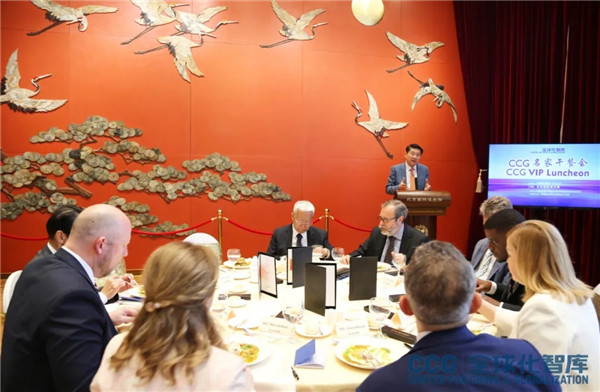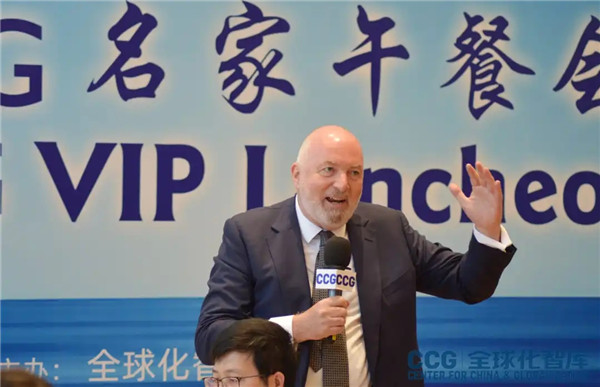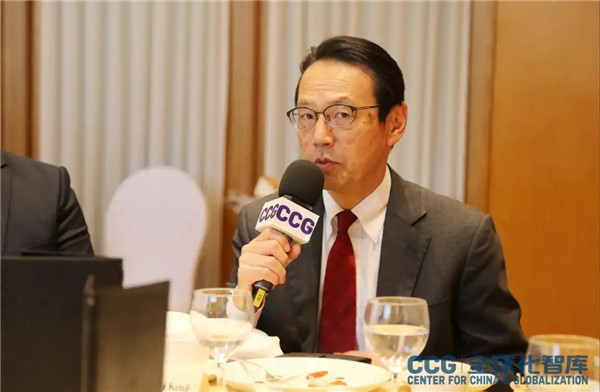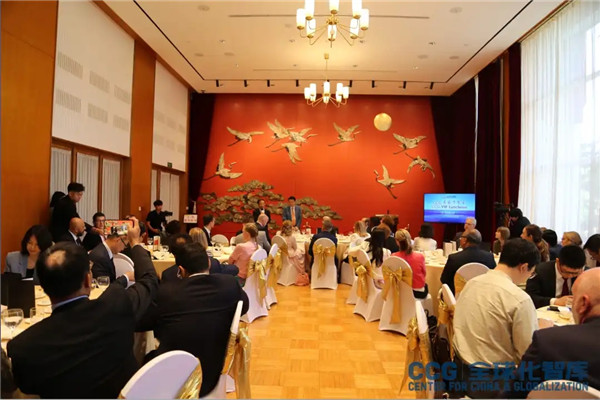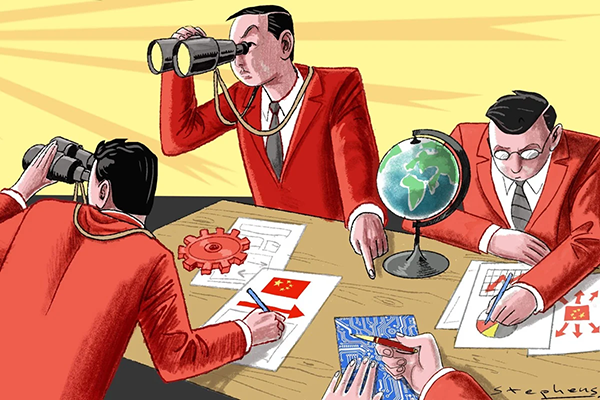Transcript of May 14 CCG VIP Luncheon on China’s economy
May 14 , 2024lds VIP Luncheon on China’s economic outlook
The Center for China and Globalization (CCG), supported by the Beijing International Club, held a CCG VIP Luncheon on Tuesday, May 14 centering on China’s economy. The luncheon was held in the historic Xianhe Hall of the club and featured Yu Yongding, former director-general of the Institute of World Economics and Politics (IWEP), former member of the Monetary Policy Committee of the People’s Bank of China; Zong Liang, chief researcher at the Bank of China Research Institute, deputy general manager of the Bank of China’s Strategic Development Department, and the vice chair of the International Finance Institute of the Bank of China; and Henry Huiyao Wang, President of CCG.
During the Q&A, a multinational corporation executive and a major country’s ambassador in China also briefly shared their views.
Below is a transcript of the event, which hasn’t been reviewed by any of the speakers. Due to the quality of the recording and the amount of work, errors inevitably exist.
A list of attendees is at the end of the post.
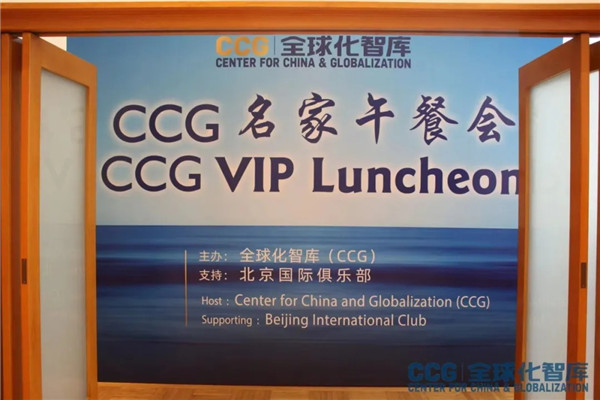
Henry Huiyao Wang

Dear ambassadors,
Dear representatives of international organizations,
Dear diplomats, multinational representatives, chamber representatives, and leaders presented.
It’s really a great honor for me to stand here. This is the former press room of the MFA before they moved into the new head office many years ago. So this is a very historic room and we have gathered here. Actually, when launching this CCG VIP Luncheon Series, we are going to do this regularly in the future. And we’re working with the Beijing International Club.
I’m very pleased to welcome all of you. As you all know, China has entered a new phase of development, and we are meeting a lot of challenges and a lot of opportunities, we would like to build a platform to have more exchanges, dialogues, and understanding. That’s the purpose of why we are inviting today two senior economists from China, Dr. Yu and Dr. Zong, to give us their views on China’s latest development – what’s the trend and what are the challenges and opportunities?
This is not the first time – we used to have an annual luncheon event, but we would like to do it more regularly after COVID. And we’re having another event on May 25 and 26 in Beijing – the 10th China and Globalization Forum. And on December 4, we will have the 9th China Global Think Tank Innovation Forum. So we just want to remind and welcome you all to attend.
I’d like Dr. Miao to start the introduction of our guests and speakers while we are enjoying our appetizers and food. And we have both food for the stomach and food for thoughts. Thank you very much.
Mabel Lu Miao
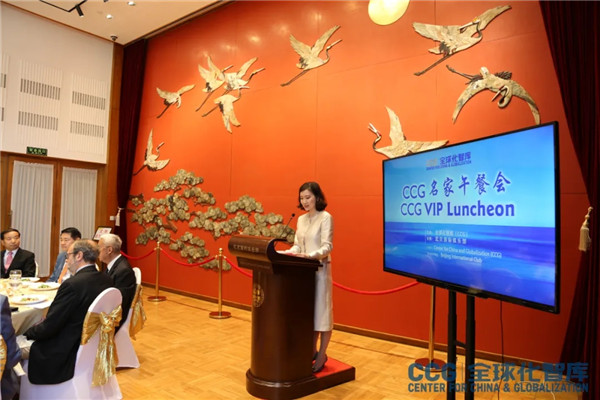
Thank you, President Wang. Next, I would like to introduce our first speaker, Dr. Yu Yongding, the former director of the Institute of World Economics and Politics (IWEP) at the Chinese Academy of Social Sciences (CASS) and former member of the Monetary Policy Committee of the People’s Bank of China.
Let me briefly introduce Dr. Yu Yongding, who is a well-known scholar in economics. Yu Yongding is an academician of the Chinese Academy of Social Sciences (CASS) and the former director-general of World Economics and Politics of the CASS. He also served as a member of the Monetary Policy Committee of the People’s Bank of China, a member of the National Advisory Board of the National Reform and Development Commission (NDRC) of PRC on the 11th Five Year Plan, and the president of the China Society of World Economy. He received a PhD in economics from the University of Oxford.
Yu Yongding has led several important research projects, conducting in-depth studies on practical issues in fields such as China’s macroeconomy, monetary policy, and national finance. Based on the development of China’s economy, he analyzed the changes in China’s international balance of payments, proposing multiple theoretic models and policy recommendations.
Later, we will invite all of us to join our Q&A period after Dr. Zong Liang’s speech. So the floor is yours, Dr. Yu.
Yu Yongding, former director-general of the Institute of World Economics and Politics (IWEP), former member of the Monetary Policy Committee of the People’s Bank of China
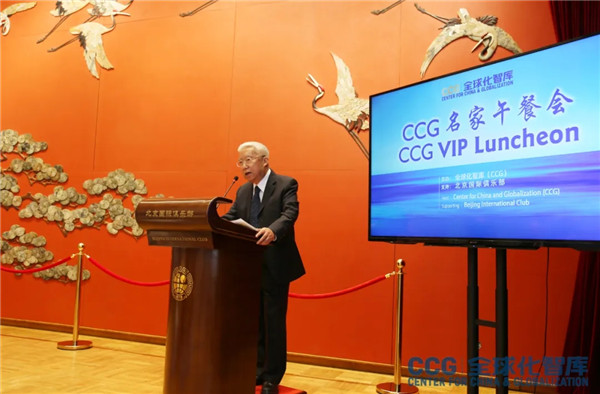
Thank you very much for your kind introduction. Actually I am a retiree. I would like to utilize this opportunity to exchange views with foreign friends. I like challenges. So after my short presentation, you can raise whatever questions. I don’t care how embarrassing the questions will be. And because I’m already 77, hopefully, I’m not senile yet, so that I can respond to your questions correctly. I think I should give you a very brief introduction about my view of the Chinese situation.
Recently there have been lots of talks about China facing a crisis. For example, our great friend Krugman said, it seems that the Chinese economy is “teetering on the edge of a crisis.” He bet many times. Sometimes he is correct, sometimes he is wrong. According to my career – I mean I have more than 40 years’ career in studying economics, especially Chinese economics. My experience is that when you are trying to predict the Chinese economy, you must be very careful.
When I was young, I tended to said China was running through a crisis – it was very dangerous, you could see some big trouble ahead, and so on and so forth. I had been saying this sort of thing for 20 years. When I grew older, I changed my position. I think, since the middle of the 1990s, I tend to think the Chinese economy is extremely resilient. So I tend to believe that the Chinese economy is okay. Even though there are problems, if you muddle through, this might catch up. Since then, I think each time, I was correct, so I increased my academic reputation. So my advice for those who are predicting that the Chinese economy is facing a crisis – be careful because then you’re trying to make this judgment because you must be very careful about your academic reputation.
But I think I have to admit that the Chinese economy really has entered a new stage. Previously, China has been able to maintain a double-digit growth rate. That’s truly a miracle. I agree that this miracle has ended. It is impossible for any country to maintain a high growth rate – something like 10% for 20, 30, and even 40 years – it is impossible. So the slowdown of the Chinese economy is quite natural.
In the first quarter of 2010, China’s growth rate was 12.2%. But in the last quarter of 2019, China’s growth rate was just 6%. From 12.2% to 6%, I think this kind of fall is quite dramatic. Is that inevitable? Is that due to something fundamental? There’s a very heavy debate among Chinese economists. Some argue that that’s inevitable because of the aging problem, because of diminishing returns of scale, because of the lack of reform – lots of arguments. In meetings, I tend to read a graph of a paper arguing why China’s slowdown is inevitable. I cite all of those factors I just mentioned that people will applaud. I’ll say, am I right? Then “I’m sorry. That paper was written by me in 1998.” After 1998, China entered the highest growth. What I tried to say at the time was that those fundamental factors will play this role in a longer run. Nobody knows when the Chinese economy will fall, let’s say, from 10% to 5% to 6% – nobody knows. When will that happen, nobody knows. So I think you must be very careful.
So there is something wrong with that kind of methodology, that is, to use long-term slow variables to explain China’s economic performance. You must be very specific – item by item. For example, we tend to say aggregate demand is very important for internal growth. Then you should analyze what are the most important components of this aggregate demand. What will be the growth rate of the aggregate demand? And what is the share of the aggregate demand in GDP? Then you do a very specific careful analysis, then come to conclusions.
In this way, I would say a few words about China’s growth rate in 2024. My question is whether it is possible for China to achieve a growth rate of 5% for 2024. My answer is yes, that’s entirely possible, but that is not that easy. For example, last year, China’s growth rate was 5.2%. Last year, China’s consumption growth rate was 8.2%. It’s impossible for China to continue to maintain the growth rate of consumption this year at 8% because last year there was a very, very important base effect. This base effect disappears this year.
So my prediction in early this year is: this year China’s growth rate of consumption will be something like 5%. I think that is quite right because, in the first quarter, China’s growth rate of consumption really fell to something like 5%. Last year, the contribution of the final consumption to GDP growth was 82%, so if this year China’s consumption growth rate will be something like 5%, then what else? For example, what should be China’s growth rate of investment? What should be China’s growth rate of net exports, so that China will be able to achieve the growth rate of 5% for this year?
I think we are facing two big challenges. One is the consumption growth rate cannot be as high as 8% like last year; and also the growth rate for real estate investment is continuing to fall. Two years ago, the growth rate of real estate investment was -10%. Last year’s was -9.6%. This year, it is so far still about -9%. So that’s a very big challenge: to offset the slowdown of the growth rate of consumption and the negative growth rate of real estate investment. And I can assume that China’s growth rate of net exports will be similar to last year. Actually, it is similar to last year – basically balanced. We have a trade surplus. But the surplus is not very big. I think it is more or less 0% or a little bit higher. So the key is whether China can maintain a quite high growth rate of investment. And among investments, one of the most important components is the investment in manufacturing. Manufacturing is something the Chinese government cannot really intervene in a big way [inaudible]. If the growth rate is 10%, it’s good; it’s 8%, it’s good; 6% is good – you can’t do much about that. There’s only one thing you can do much about – that is an investment in infrastructure.
According to my rough calculation, this year’s growth rate of investment in infrastructure should be much higher than last year. I will not give you figures. It’s double-digit. The growth should be double-digit. [inaudible] If the Chinese government does not make its fiscal policy more expansive, the infrastructure investment will achieve a double-digit growth rate. So I think this is a very important issue.
As a result, my policy suggestion is that China should further increase its government budget deficit, although according to this year’s plan, the budget deficit is already quite high, at 3.8%. Usually, China will stick to the line of 3%, below 3%; but this year, 3.8%. But if you use the definition of the IMF and other international organizations, the so-called augmented budget deficit is very high, something like 8%. I think it’s a worry, but we should not be scared. The United States, in 2020, had a budget deficit rate of 15%. Right now, I think it’s more than 5%. According to [inaudible], in the future, the US budget deficit-to-GDP ratio will be maintained at the level of 5% based on the official statistics.
So what I’m trying to say is that China’s fiscal position is still quite okay compared to most other countries. So the Chinese government should be bolder to use more expansive fiscal policies to issue more government bonds to finance investment in infrastructure. Of course, this view is quite controversial within China. I think I may be in the minority. Okay, you can raise questions.
This is my key point. In order to allow the Chinese government to issue more bonds to finance investment in infrastructure, then China’s central bank, the People’s Bank of China, should really play a more active and supporting role in more expansionary fiscal policy. I think tomorrow or a few days later, the Ministry of Finance is going to issue long-term bonds, more-than-30-years long-term bonds. That’s something unusual in China. I think that is a test case – whether this bond can be issued smoothly, and whether people will buy those funds. I think that’s very important. If people are not so active in buying bonds, of course, yields will shoot up.
I think now is the place for the Chinese banking system to play its role. So I think the Chinese government should encourage the People’s Bank of China to increase its open market operation. You can say this is sort of QE (quantitative easing). I don’t care; QE or not QE. Anyway, the People’s Bank of China should create a sort of environment to suppress its rise in the yield curve so that the Ministry of Finance can issue government bonds smoothly. If the Ministry of Finance can issue the bonds smoothly, and if local governments and enterprises can get enough funding, if the growth rate of investment in infrastructure can reach something like double-digit, I think there should be no question elsewhere for China to achieve the growth rate of 5%. Of course, it’s a challenge. Nobody knows whether we will be able to succeed in this regard. But anyway, this is my personal view. Of course, perhaps in your minds, there are lots of other questions – overcapacity, trade issues, RMB, and so on and so forth. I think I should stop here and leave it to Dr. Zong Liang to make this presentation. I’m here. I’m ready for education. Thank you.
Mabel Lu Miao
Thank you very much, Dr. Yu. Next, we would like to invite another distinguished speaker, Dr. Zong Liang. He is the chief researcher at the Bank of China Research Institute, deputy general manager of the Bank of China’s Strategic Development Department, and the vice chair of the International Finance Institute of the Bank of China.
His professional journey includes significant contributions as an expert in government and academic organizations. Zong Liang’s research spans multiple areas of finance and economics, leading numerous national and provincial projects, and authoring extensive scholarly articles and books on topics such as RMB, internationalization, and global financial reforms. His academic performance is recognized in his roles as a standing director and vice chairman in key financial societies and communities. So the floor is yours, Dr. Zong.
Zong Liang, chief researcher at the Bank of China Research Institute
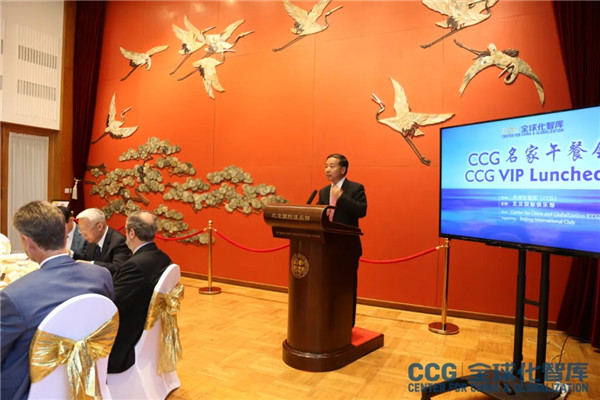
Distinguish guests,
Ladies and gentlemen,
Leaders and experts,
It’s my pleasure to participate in this meeting. And I think I haven’t seen a lot of foreigners in one place in China for a long time. Today I want to exchange my views from three aspects.
One is about the Chinese economy. In China last year, 2023, the Chinese economy’s GDP growth was 5.2%. This is not very high compared with the past, but in these two years, this is good. In the world, the average growth rate is merely about 3%. In developing countries and emerging countries, it is about 4%. In Asian developing countries, it is about 4.5%. And the growth rate of developed countries is about 1.5%. So according to this, we can have the criteria – if your country’s GDP growth is higher than that, then your economy is probably doing well.
In the first quarter of this year, China’s GDP growth rate was 5.3%. Consumption [retail sales of consumer goods] grew by 4.7% and investment [fixed asset investment] grew by 4.5%. And total imports and exports increased by about 5%. But in April, the figure is higher. The exports increased by 1.5% and the imports jumped by 8.4%. But this is in U.S. dollars terms. Investment in private manufacturing grew in the first quarter at about 11.9%. This does not include real estate and private enterprises.
I just heard from a general manager from a German company who said his company sold 760,000 cars in China. But in the United States, the figure stands at just 300,000. In the German market, it is 280,000. The Chinese market equals more than the U.S. market plus the German market. So the Chinese market is very big and is very important.
This year, China’s GDP growth target is about 5%. I think this is a moderate and a leading rate in the world. But China’s economy also faces some problems, such as real estate, some small financial institutions, and local government debt. I think this is the problem. China should promote proactive fiscal policy. As for monetary policy, it should decrease interest rates and increase M2 and social financing. I believe China will calculate the economic situation and take measures accordingly in the future.
In China, a lot of people pay much attention to the real estate. Of course, the real estate market is very important, but it has some problems now. Property investment in China fell 9.5% in the first quarter of 2024. Since the real estate sector is the current driver of China’s economy, it has dragged down the economy by about 0.7%. This means if the real estate market takes up zero contribution, China’s economic growth rate now should be 5.3% plus 0.7%, which is 6%, just like in the past. It is possible that every year, China’s GDP growth rate will increase by about 0.5 to 0.7 percentage points.
Due to the slump in real estate, which is a great driver for the Chinese economy, as well as issues on both the demand and supply sides, the market expectation is experiencing some problems. But recently, a lot of cities such as Shanghai, Xi’an, and Hangzhou have relaxed the limitations on purchasing houses. This is a very big policy. I think in the long run, China will increase and then improve the supply of houses and also, increase the demand for houses. For example, for young men and women who want to have more children and who want to live a better life, a house is very important. We must give them very good conditions to buy a house for their families.
Second, I want to talk about overcapacity. This is a problem raised, or rather manufactured by the United States. I don’t want to comment on this problem theoretically. I just want to make a comment in common sense. One day, one of my students said to me, “The new energy vehicle is a very good product, a very great product, and a high-end product. In the future, we may probably all use the new energy vehicle. Why did the United States raise this problem and say you are wrong?” She said that she was proud of this. I looked at her for a moment. I didn’t say anything and then she said, “Oh yes, just like you said, this is a manufactured problem.” So I think in a world where green products mean the future, we should protect this kind of innovation. If these new products are made in the United States, in Germany, and in other countries, we wouldn’t say this is bad for China. I think we must deal with this kind of problem.
And I want to explain why the overcapacity issue is very important. We want a peaceful world, but I think there is an overcapacity of military weapons and products. I mean, for example, there are military weapons sent to the Gaza Strip, which will kill a lot of people and is very dangerous.
Third, I want to talk about the opening-up policy of China. Opening up is a basic state policy of China. And this is very important. President Xi just visited three European countries – France, Serbia, and Hungary. Not only does it mean that China pays much attention to Europe and a lot of other countries, but it also means China is opening up its economy. I would like to mention an example. Coffee is not from China. In the past, I didn’t drink coffee, but now every day I must drink a cup of coffee. Today, the coffee is imported from Vietnam, Brazil, Ethiopia, and a lot of places. Shanghai has the world’s most coffee shops – about 8,000 coffee shops. So this can be very special. The China International Import Expo is held every year in Shanghai. I think China is a very favorable market and China wants to share this market with all the friends from the world. In the future, we will continue to share the market with enterprises from different countries. And we believe you can invest in China and get benefits from China.
Mabel Lu Miao
Thank you, Dr. Zong. And thank you, Dr. Yu, for your wonderful speeches. Next, I would like to invite Dr. Henry Huiyao Wang, President and Founder of CCG, to give comments, share his part, and take the Q&A.
Henry Huiyao Wang
Thank you. Please continue your lunch. Thank you, Dr. Yu and Dr. Zong, for opening remarks on their research and also their forecasting. Later, we’re going to take some Q&A, so we hope that you will raise questions for our experts. But I would also like to speak as a think tank because this is an opportunity where we can mention a bit about our research and our findings.
We know that our international friends have some concerns about the Chinese economic growth, but as we have found, the first quarter of the Chinese economic growth is better than expected- it reached 5.3%. And as Dr. Yu mentioned, we will continue to achieve better growth. And of course, as Dr. Zong mentioned, recently, about 20 cities – first-tier and secondary-tier cities – have lifted restrictions on the real estate market. So that means we’re going to have a lot of coming back again.
One of the things I think we have heard quite a lot about is this “overcapacity.” I just want to cite a number to say that in China, this overcapacity issue is and still will be a good thing because it wasn’t really overcapacity; it was under-capacity. For example, the International Energy Agency (IEA) forecasts that the global demand for new solar installation and solar power installation will reach 820 gigawatts, about four times that of 2022. So we’re only meeting a quarter of the global demand, according to the IEA numbers. It’s far from oversupply.
The other thing is clean energy investment. According to the IEA again, 4.5 trillion clean energy investment should stand, but now it only stands at 1.8 trillion. Again, that’s not enough. So I think this is also a pressing issue.
Also, I have come back from Germany’s Global Solutions Summit and also from Italy’s Limes Forum. I understand and am also concerned about that. So I’d like to share with you some bright spots. We know that in July, the Communist Party of China (CPC) will open its Third Plenum. I remember President Xi actually mentioned that when he was meeting the U.S. executive, strategic, and academic experts; he was saying that China is contemplating and has a lot of new policies in the making. So I think by the Third Plenum of July, which is already announced, we’re gonna expect some policies coming from the central government to build up on the momentum that I think China is having – the economy is growing, the money is coming back, and the investment on those government is rising. There’s a lot of good news coming up.
I remember what Premier Li Qiang said in March at the China Development Forum; I think he was saying that the urbanization of China would be the economy’s next biggest driver. He was saying that there is about 66% of the Chinese people living in urban cities. But the [proportion of] people who have the hukou (household registration) and enjoy the social benefits is only 50%. So there are actually about 300 million migrant workers in the city. They would be great new forces for consumption and development.
I think every 10 years in the past 45 years, China always had a big policy. For example, in the 1980s, the government proposed we should contract land to the farmers so they can grow whatever they like. That policy made China from an economy of shortage to an economy of abundance. That was the big policy in the 80s. In the 90s, the government proposed we should let workers have flats in the cities. A very minimal amount of purchase support was allocated to them, and all the flats in the city were privatized. So workers have the purchase right and they have the household right. And that urban housing policy has driven out of China a real estate boom for the last 30 years, basically since the 90s. So you can see every 10 years, there’s a big policy. And in the year 2000, the big policy was China joining the WTO. There used to be only a number of state-owned enterprises in the country. Now there are 6 billion Chinese companies in the country. So China became the largest trading nation in the world.
So now we are looking for similar big policies that really can drive up the Chinese economy. As a think tank, there could be another interesting policy that we would like to propose. For example, we know these 300 million migrant workers: they are living in the city, renting low-grade houses or apartments in the city. But in their countryside, they have their household land. The household land is vacant, [occupied] only with the seniors and youngsters. That’s why you see nine billion people travel around during the Chinese New Year – that’s unprecedented in the world. But the problem is that out of these 300 million migrant workers, most of them are brought up in the city. They cannot go back to the old home, to the rural home. For example, Guangdong province, before the opening up, had 6 million people; now it has over 100 million people. The 40 million people living there are coming from different parts of China, and they all live in Guangdong. Shenzhen has 20 million people, with 10 million of them without hukou. Dongguan has 10 million people, and 8 million [has no hukou]. So I think absorbing those people and allowing them to integrate into the cities would probably be the next biggest policy in China, really driving our economy.
One of the policies I think we can come back to is allowing those households in the rural areas, the non-farmers to sell their household in the rural areas so they can have the town payment back in the city to buy second-hand or third-hand apartments. The 300 million people can really use all the vacancies, those reported empty newly-built departments. If in the 90s, the Chinese government allowed workers in the city to privatize their apartments, can we allow the farmers to privatize their household land so they can have some startup capital to really settle down in the city and their parents and children can stay in the city? The development unleashed by 300 million workers could be enormous, driving up the next 10 to 20 years for China.
So Li Qiang mentioned at the China Development Forum how to integrate migrant workers, the urbanization of these younger people may be the next biggest driver to the Chinese economy. So I think we have a lot to watch for.
I just wanted to share a bit about our research and our thinking. Now we are open for the Q&A for our speakers. You are welcome to raise any questions or comments. We still have time and let’s get into the Q&A.
Keith Bradsher, The New York Times
Just asking a trade question since you mentioned it. Let’s leave overcapacity for later. There have been concerns in the auto industry that there is enormous capacity, for example, to build gasoline-powered cars. But a whole new industry is being built to manufacture electric cars. Does that cause overcapacity or is that a natural industrial evolution? What is that gonna do to car prices and is in turn most [inaudible] for the economy?
Yu Yongding
Long time no see. I’m not an expert in this area. I recommend you go to the Institute (of World Economics and Politics) to see some younger experts. They did a lot of investigations.
Firstly, overcapacity is a sectoral concept, not a macroeconomic concept. Anywhere you look, you will find in capitalist countries, there are cyclical overcapacity crises. Hence, the problem is not overcapacity – I mean, at the macroeconomic level – the problem is lack of effective demand. So if we peak on capacity and then increase demand, the question is solved. But that is a macroeconomic way. So I think we should not confuse this whole concept of macro level and sectoral level overcapacity.
Then at the sectoral level, I think that the sometimes overcapacity in certain fields is quite natural, then there’s a fall in prices, then there’s a reduction of production; there’s a lack of capacity, and then the price rises. So it is quite a natural cyclical phenomenon. Yes, in this stage, I think that EVs are in the stage of overcapacity. So they compete with each other. So according to some carmakers in China, we predict that in the next few years, the most of the Chinese carmakers will go bankrupt. So the capacity will be reduced, reaching a new equilibrium.
I think that’s very natural. You should not be scared, right? So you compete with China. If you ask whether China has abided by the rules of the WTO, I think that’s the key. When you are in the fields, racing, you should not try to stop the first runner so that you can catch up. You should try your best, right? So I think that’s the right approach.
I’m very disappointed by Yellen’s comment on China’s overcapacity. I respect her. She is a great economist. She should not borrow those kinds of thinking or phrases from politicians.
Henry Huiyao Wang
Thank you. I think one thing we have to remember about overcapacity is that Tesla makes half of its EVs in China, right? They also export everywhere. Mercedes-Benz Executive Vice President Yan is in the room. They have a big R&D center. I don’t know if you produce EVs a lot; some companies do. So maybe you could share a bit of about the auto industry from a multinational’s point of view.
Yan LENG, Executive Vice President External Affairs & Public Policy, Daimler AG China
Thank you for giving me this opportunity.
Coming back to the automobile industry. As an international company focusing on the premium segment, we cannot complain. So far, the performance we have in China is quite okay, even compared to the last years. Sure, the record year we have was 2020. We sold in total around 0.76 million cars here in China (in 2023), so that’s more than the US market and German market combined, or even bigger than the EU market.
You mentioned the two sessions [Third Plenum]. We were also looking forward to some very promising signals so that the confidence in the market will increase. Right now, we believe that this year’s policy target of 5% (GDP growth) will be achieved if there are stimulus policies. Recently, we have seen the trade-in programs for car replacement. But we are still cautiously optimistic about the years to come because of the confidence in the market, especially among the private entrepreneurs. It’s still an issue you cannot ignore because in the past, you mentioned all the success stories in China in the past four decades, but the major investment we have seen in the past three years as a decade came from either private investment or overseas investment, including Hong Kong and Taiwan. So next, we hope with the doubling-down of efforts to attract foreign investment, this trend will come again. We need to think to figure out what are the real measures that will enable the quick recovery and rewinding of the Chinese economy.
So in total, we cannot complain; we’re okay. We are also willing to invest more because the Chinese auto market here is, in terms of electrification, digitalization, and the new application of technologies on cars, you can say the Chinese automotive industry is right now the most dynamic one, and in certain areas, also the leading. So we want to catch up with this development here. And by the way, not any commercial ads, but we are offering almost every combustion engine model an electrified version.
At the Auto Show in April, we officially launched the electrical G Class. It is equivalent to the traditional (model). So I welcome you to continue to be customers of Mercedes-Benz. You are welcome to buy if you have any interest in electric cars.
Alfredo Montufar-Helu, The Conference Board
Hello everyone. My name is Alfredo from The Conference Board. Very nice to hear from [Yan] Leng. They’re our clients and members. But I just want to touch a little bit on what he said.
I think there’s no question that China will achieve its target of around 5%. It’s a mathematical calculation. Q1 was 5.3%, therefore reducing the need of growth in the next quarters in terms of the numbers. So it’s just a mathematical calculation, right?
And it brings me back to aggregate demand, which is: it’s about confidence, right? I mean, whatever growth we’re seeing in numbers, we’re just not feeling like it. It’s about confidence and effective demand. Professor, you were talking about effective demand. Short-term, yes. Investment to offset the real estate investment, sure. Manufacturing and infrastructure are needed. Fiscal policy is needed. But sustainability requires effective demand. And that’s more structural and cyclical. It’s as you were saying, you have to reduce people’s need for precautionary savings and that requires years of reforms.
So my question to our speakers is: What do you think about those structural challenges that China is facing? How to address them? What is the timeframe that you will put on this? Because again, 5% growth this year is achievable and China will continue expanding its economy. But the thing is that if this year, you don’t have the economy really reactivated, the next year’s gonna be really hard to achieve whatever target they set. So in the long term, what do you think about the structural imbalances and how to address them? Thank you.
Yu Yongding
A very good question. I think the discussion on this topic is very intensive among Chinese scholars. My personal view is that confidence at this moment is the No.1 issue. If you have confidence in the future, you spend more, invest more, and so and forth, the goals will be sustained. Why is confidence not as strong? I think this COVID, of course, is the culprit. People are not so confident because of COVID.
But my personal view is that China’s slowdown has been a long-term process, as I just mentioned, starting from 2010, more obviously starting from 2013; gradually on a yearly basis, even on a quarterly basis. If an economy slows down in that fashion – quarterly, yearly, continuously, definitely, people will have a confidence problem.
What is the cause? As I just mentioned, there are some fundamental, longer causes, but that is not enough to explain why you have a yearly and quarterly slowdown in the growth rate. So there are a lot of problems – sectoral, structural, and institutional problems, and so on and so forth. My focus is on macroeconomic policy. It is certain in some respect that China’s slowdown was policy-induced. We had a four-trillion [yuan] stimulus package which was very successful. So in 2010, China achieved a growth rate of 12.4% in the first quarter. But at the time, the Chinese government was also scared. Why? Because people said it was a bubble; because inflation was worsening. In 2011, the inflation rate in China was more than 5.6%. That was intolerable for the Chinese government and the ordinary people. So the Chinese government shifted gears. The policy direction shifted very quickly. In 2011, China’s budget deficit fell to just 1.1%, while other countries continued to implement expansionary fiscal and monetary policies.
China’s credit growth also fell [inaudible]. In 2009, China’s newly added credit was 9.6 trillion RMB. But in 2011, it fell to something like 7 trillion. Fiscal policy and monetary policy shifted very dramatically. Of course, this will have a very important impact on growth because previously people made plans according to certain expectations, but suddenly, the current policy goal changed very quickly. So this caused some interruption. This is one thing. I think China made a mistake, that is, a withdrawal from expansionary fiscal and monetary policy. [inaudible].
Second, starting from March of 2012, China’s PPI (producer price index) entered into negative territory for 54 months. Then starting from 2019, it entered the negative territory again for 23 months. Then starting from 2022 up until now it is still in negative territory. That was PPI. CPI fell below 3% since May 2012. Now it hovered around 2%. Then last year, it was something like 1% or 0%. So definitely this is a very low inflation. Some people say this is a deflation or quasi-deflation. While inflation is so low and at the same time the growth rate is falling, what should be the right policies for us? Obviously, expansionary fiscal and monetary policy is the policy adopted by almost all countries. But we are very cautious about real estate, inflation, and so on and so forth, so they [the Chinese government] refrain from using more expansionary fiscal and monetary policy. The emphasis is to cut overcapacity. We have repeated this for 10 years. Each year you check the Government Work Report, there’s a word: cut or eliminate overcapacity.
So this approach changed. I’m very happy with this change. Since 2023, the Chinese government has focused on aggregate demand, saying the most important problem we are facing is a lack of aggregate demand. So we changed our policy approach. I think this is [inaudible] why Chinese economic growth is getting revived. That’s very important. As Deng Xiaoping said, development/growth is the key. Without development/growth, you can do nothing. Nothing.
If the economy’s not in recession, talk reform and an equal income distribution, and other things are very important. So No. 1 is to reverse this kind of trend. I think we will be successful in this regard. And with a high growth rate, say, to stabilize more than 5%, then confidence will increase, then we can make the income contribution more equal, we can increase tax and improve China’s social security system, and so on and so forth. Then we carry on with a more structural reform. So I think China’s goal will be to sustain, not up to 10%, but 5% for another ten or twenty years. I think that will be good enough.
Henry Huiyao Wang
Yes, thank you. I just want to briefly comment on that. Absolutely, confidence is the very important key for the next decade or two of growth in China. But I think you know China has all the synergy, the best infrastructure in the world. You know, 70% of the 5G system is in China; 70% of the fast-train network is in China. And you have 12 million fresh graduates talent in China, most of them single children, well-educated. And out of the 10 largest container ports, seven of them are in China. You have all the synergy there that is going to make force.
One of the things we hear a lot when we travel overseas and they always say is, oh, you have a very high youth unemployment rate in China. But I think we have to really look at the details. There are about 95 million people aged between 16 and 24 who are classified as youth. And out of this 95 million, 60 million are in universities, vocational schools, and senior high schools. They’re not really working. So, if you exclude that, it’s about 30 million. Then the youth unemployment rate is not that high. It used to be 20%. Now, after that, it’s about less than 10%. So, we have to look at the real numbers. But let’s continue the discussion. We have a representative of UNICEF.
Amakobe Sande, UNICEF Representative in China
First of all, thank you for reaching us, and thank you to the two presenters. Henry already tackled my question. Because I’m from UNICEF, my focus is on children and younger people. So I was going to ask the presenters because they haven’t touched on the unemployment issue.
But the other thing I wanted to highlight, too, is to get an understanding in terms of the subnational level and the recovery of provinces. Because we understand even from the work that we do, that they are high levels of indebtedness at the subnational level. That has an impact, obviously, on what we do with communities and in the social worker network. So, to get a sense of what it’s looking like now, so the unemployment question in general, which you’ve started to tackle, but there is also the subnational recovery and how that’s looking as well as projections.
But I did want to thank you, Henry, for raising the issue of migration, and we would really like to partner with you on that because linked to that is the fact that 70 million children are left behind by parents who migrated into the cities. And if you’re talking about proposing reforms in that area, we would certainly like to collaborate.
Henry Huiyao Wang
Yes, that’s actually, I think that’s probably the lowest-hanging fruit in China: how to really urbanize these 70 million people who grew up in the city, and whose parents and children are still in the rural area, whose household land is growing grass, or have a big, empty house. It’s a huge waste of big houses in both places: poor houses in the city, and big houses in the rural area. We have Madam Li Wen here. She is the new representative of the International Organization for Migration. She has just recently joined us in China. But maybe we will have another question. Then we have the speakers to address that.
Denis Staunton, China Correspondent, Irish Times
Then, my name is Denis Staunton from the Irish Times. I wanted to ask you about how you would calculate the potential impact on China’s economic performance of some of the trade protection measures that have been discussed in the United States and in Europe if we imagine that the harder end of the spectrum was being discussed; and when China is considering how to respond, what economic calculations that they should be taken into account in making that decision.
Q [unidentified]
Thank you so much for this very informative invitation and index of insights into the Chinese economy. The healthy Chinese growth has a positive impact on the global scale in general. And here’s my question: for fastly developing partners of China, what possible impacts and scenarios can you envisage regarding the situation now in China? And what possible trajectory can you expect in regard to the commitments and the partnership programs that investment in China has with so many countries in the Belt and Road Initiative? [inaudible]. Thank you.
Yu Yongding
I am not the right person to answer all those questions, but I will try my best. I think at this stage, China worries about development/growth most, right? We should have a higher growth rate. Under this kind of general environment, export is encouraged. All enterprises that have so-called overcapacity want to export, for example, to China’s neighboring countries. Also, Chinese neighboring countries welcome this kind of investment because it’s mutually beneficial.
But I worry about this kind of situation. Number one, China has been running a current account surplus for many decades. China has accumulated more than 9 trillion US Dollars in foreign assets. We have more than 2 trillion net assets, mostly U.S. dollar-denominated. There are some questions. Guess what is the US net debt-to-GDP ratio? What is the US net debt? The recent figure is 18 trillion US dollars. The net debt-to-GDP ratio is more than 70%, sometimes 80%, depending on the evaluation effect. So, the biggest debtor is the United States. And everybody knows, Keynes’ saying, if you owe a bank ten thousand pounds, you are at the mercy of the bank. If you owe the bank one million pounds, then the bank is at your mercy. China is the bank.
So definitely China should not continue this kind of export-driven [approach]. Actually, we have been raising this question more than 20, even 30 years ago – China should run a more balanced current account. So this is why in the early 2000s, the People’s Bank of China had decided we should detach from the US dollar. We should allow the RMB to be appreciated. Appreciation can make China’s trade more balanced. But unfortunately, because capital kept an outflow, which offset the current account surplus. The RMB has been falling. This is the problem we need to solve. Previously, China just allowed RMB to appreciate to balance of the current account. But now we are losing this very important instrument. What should we do? So actually, now we are thinking about very hard about this.
This is why the Chinese government raised a new development strategy – the dual circulation strategy, emphasizing domestic demand. Actually, we have made some achievements. Say, in 2006, China’s current account surplus-to-GDP ratio was more than 10%. Now it’s hovering around 1%. We have made a very big improvement, but that is not enough.
So our view is that Chinese enterprises should really implement this new growth strategy and the Chinese government should help enterprises to finish this transformation – to depend more on domestic demand and less on external demand. I think it is a very important strategy. We are making some progress so far.
At the same time, because, as we just mentioned, there is some sectoral overcapacity, the Chinese government actually encourages helping enterprises to invest in other countries, especially in countries around the Belt and Road. [inaudible]
At the same time, I must confess, for me at least, I am a little worried about the safety of China’s investments. Once upon a time, I was visiting a very friendly country. I asked, what is your country’s debt-to-GDP ratio. He said, 70%. I said, wow, so high. He was laughing. I asked, why are you laughing? He said, we owe all the debt to you. [inaudible]
So we have to strike a balance in this. We need cooperation with our neighbors so we can utilize [inaudible] certain plans so that we can cooperate better. China welcomes your exports to China, from the U.S. Also, the safety of China’s investments in foreign countries is very important. Just recently, Chinese engineers were attacked and killed in Pakistan. If these kinds of things happen very often, that is a very big problem. Okay, I think I should stop here.
Li Wen, General Representative of International Organization for Migration (IOM) in China
I’m Li Wen with the IOM (International Organization for Migration).
Henry just raised an issue of migrant workers. So I want to ask a question from the international migration perspective. To sustain economic growth, labor forces are [necessary]. But Chinese society is aging and the growth rate has been on the decline for years. Of course, we are trying to leverage domestic migration to sustain economic growth. But do you think, from the economist’s perspective, that we will ever come to a point where we have to have international migrant workers to fill in the labor market shortage gap? I’ve also heard some people saying that because the absolute number of the Chinese population is so big, even with the declining birth rate, we will never be in the same situation as many European countries, Japan, or Korea are in today. I think I know where Henry stands on this issue, but I want to hear other experts’ opinions.
Henry Huiyao Wang
I don’t know if the Japanese Ambassador will share the Japanese experience because we all have this problem. Of course, it is very difficult, but Japan is a little ahead of us. But I think the percentage of migrants in Japan is getting up a little bit. Maybe that’s the same thing in South Korea.
Kenji Kanasugi, Ambassador of Japan to China
Hello. Thank you very much. My name is Kenji Kanasugi from Japan. We haven’t been able to have much success in our endeavors. Our birth rate stands at 1.3% and our population is declining by more than 500,000 every year, meaning that we lose 1 million population every two years. So in order to cope with that, we encourage women’s empowerment, meaning that let women come back to the workforce after getting married or giving birth to children.
Second, let seniors like me continue working.
Number three is about foreign workers. But we adapted not migration as such. We let foreign workers come to Japan on a temporary basis. After accumulating some skills in Japan, they would go back to their home country so that they could contribute to the development of their countries. But again, despite all our efforts, we have not been able to make success in our data. So there is no [inaudible] on the Chinese side. Thank you.
Henry Huiyao Wang
Okay. Maybe I will ask Professor Yu to say a few words. But before doing that, I would like to add that Japan and South Korea have the same issue, but they are ahead of China. So I think China’s global migration would probably follow what Japan and South Korea do, because the global migration in China is the lowest in the world, even 10 times lower than India, 0.1% and 0.01%. So Japan has gone to 3%. I think South Korea has 3%. And that probably will be the trend for China in the future.
Yu Yongding
I think Japan and Korea have set an example for China, and China may study their experience very carefully. But I think at this stage, we haven’t reached that kind of stage yet because as Henry just mentioned, we still have a tremendous room for urbanization. And actually, China’s problem is not that serious in terms of a lack of labor supply. Unemployment is a very big issue, right? People’s attitude is also important. I think there’s a tendency of convergence among young people. Young people don’t want to work as hard as their parents because they want to enjoy life. Because I’m an old guy, nearly 80, I don’t think I have a position – I have no right to make these comments. It’s the young people’s choice.
Zong Liang
There are a lot of areas I want to say something about. For example, more than 40 years ago, I lived in a very small village. Now I live in Beijing. And so you can see from this situation, you can see and China has greatly changed. You couldn’t think of the fact that starting in a small village in the past, now I can give a speech here. So from my side, in China, if you want to do such a thing as carry out an investigation, I think you will learn a lot of practical experience.[inaudible]
Another question I want to address is “invest in China.” In Taicang, a small county in Jiangsu Province, there are about 500 enterprises from Germany. More than 60 enterprises in Taicang are the hidden champions in their niche sectors. There is a very special Japanese-style district. You can visit there and drink a beer at the festival. It was named the “home of German enterprises.” Investing in China is very good, especially with a lot of enterprises together within an area. Also, China has a safe environment for private enterprises. You can wander anywhere at midnight, no matter if you are a man or a woman, even if you are alone. You wouldn’t incur any risk. So I think in the future, if someone migrates to China to have a better life, I think it’s okay.
Foreign diplomats in China attending this event include H.E. Mr. Assem Hanafi, Ambassador of Egypt to China, H.E. Mr. Hallam Henry, Ambassador of Barbados to China, H.E. Mr. Thorir Ibsen, Ambassador of Iceland to China, H.E. Ms. Milia Jabbour, Ambassador of Lebanon to China, H.E. Mr. Kanasugi Kenji, Ambassador of Japan to China, H.E. Ms. Maija Manika, Ambassador of Latvia to China, H.E. Mr. Grahame Morton, Ambassador of New Zealand to China, H.E. Mr. Paulo Jorge Nascimento, Ambassador of Portugal to China, H.E. Alenka Suhadolnik, Ambassador of Slovenia to China, Tone Helene Aarrvik, Counsellor, Head of Economic Team, Embassy of Norway, Thibault Alix, Financial Attaché, Embassy of France to China, Richard Blackwood, Acting Unit Chief, Strategic Industries and Trade Unit, Economic Section at the U.S. Embassy in China, Cristina Carenza, Deputy Chief of Mission, Embassy of Italy, Jacob Cutts, First Secretary, Embassy of Canada to China, Maja Frankovi?, Minister Counsellor, Economic Affairs, Embassy of Croatia to China, Robert Gillespie, First Secretary Head of Economic Analysis, British Embassy to China, Andrea Katharina, Commercial Counsellor, Embassy of Germany to China, Dean Lee, Counsellor, Embassy of Singapore to China, Atakan Ozdemir, Chief Trade Counsellor, Embassy of Turkey to China, Adam Pickford, Economic Counsellor, British Embassy to China, Bernhard Schwartlander, Global Health Envoy, Embassy of Germany to China, Asaf Shirman, Financial Attaché, Embassy of Israel to China, Abhishek Shukla, Deputy Chief of Mission, Embassy of India to China, Parulian Silalahi, Minister & Deputy Chief of Mission, Embassy of Indonesia to China, Jan Sitar, Commercial Counsellor, Economic Affairs, Embassy of Slovenia, Mojca Dezelak, Deputy Head of Mission at the Embassy of Slovenia in China.
Representatives from international organizations and business associations attending this event include Stephan Bernhardt, Vice Chairman, European Union Chamber of Commerce in China; Adam Dunett, Secretary General of the European Chamber of Commerce; Viola De Canossa, Development Economist and Head of Policy and Research Team of UNDP; Kevin Chua, Senior Economist at the World Bank; Tamas Hajba, OECD Representative in China; Alfredo Montufar-Helu, Head of the China Center for Economics and Business at The Conference Board; Li Wen, Chief of Mission, IOM; Elitza Mileva, Lead Economist & Program Lead of Equitable Growth, World Bank; Martin Mueller, Honorary Chairman of the Swiss Chinese Chamber of Commerce(SwissCham); Ira Ovesen, Deputy Representative of UNFPA in China; Qin Hu, Vice President of Environmental Defense Fund (EDF), Chief Representative of Beijing Office; Amakobe Sande, UNICEF Representative in China; Shaikh Muhammad Shariq, Representative of National Bank of Pakistan in China; Smriti Aryal, Head of China Office, UN Women.
The multinational corporation representatives attending this event include Agnes Cui, Vice President, Government Relations, Greater China, IBM; Jerry Guo, Managing Director, KKR Capital Group; Shauna Huang, Vice President, External Affairs, Universal Pictures China; LENG Yan, Executive Vice President, Daimer Greater China; Miranda Wang, Managing Director, ETS China.
International media representatives attending this event include Keith Bradsher, Beijing Bureau Chief, The New York Times; Jonathan Cheng, China Bureau Chief, The Wall Street Journal; Denis Staunton, China Correspondent and Beijing Bureau Chief, Irish Times; XIAO Xiao, The Wall Street Journal.
Topical News See more

